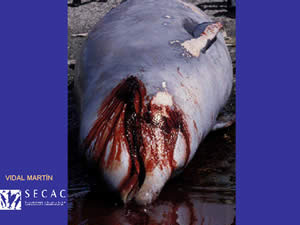

 |
 |
Low Frequency Active Sonar (LFAS)
What Is It?
Low Frequency Active Sonar (LFAS) is a military sonar technology designed to detect and track quiet submarines. The U.S. Navy is planning to deploy LFAS in 80% of the world’s oceans. NATO and other Navies also have this technology. Individuals and organizations have expressed concern about the potential impact of LFAS (including deafness, tissue rupture and stranding) on marine mammals, fish and other marine life because it is transmitted at very high decibel levels and travels over long distances. Studies have shown that noise can disrupt development of fish eggs and larva and affect reproductive processes. Using the Navy’s conversion factor, the source level of LFAS is equivalent to being 20 feet away from a Saturn V rocket at take-off. One ship deploying LFAS could affect an ocean area the size of Texas. In 1996, after testing LFAS secretly for years, the U.S. Navy agreed to prepare an Environmental Impact Statement (EIS) and delay further use of LFAS. Consequently, the Navy designed a scientific research program (SRP) to study the short-term behavioral responses of 4 species of baleen whales to playbacks of LFAS transmissions at decibel levels much lower than intended deployment levels. On the basis of this limited, low level testing the Navy concluded in their Final Environmental Impact Statement (FEIS) on LFAS that it is safe to expose marine mammals to LFAS at sound pressure levels of 180 dB and lower. In fact, the SRP never exposed whales to sound pressure levels above 155 dB. The Navy acknowledges in the FEIS that "the lack of empirical data in the received level range of 155-180 dB is an issue." |
Beaked whale from the Canary Island stranding of September, 2002.  This stranding took place during naval exercises involving the same mid-frequency sonar used during the Bahamas stranding (March, 2000). Eighteen European scientists published a letter in Nature (October 9, 2003) suggesting that the whales that died in the Canary Islands stranding appeared to have a type of decompression sickness (bubble formation) in various tissues possibly due to the high intensity sonar. They collectively called for regulation and limitation of the use of these sonars. |
The Navy released the FEIS in January 2001. Two months later the National Marine Fisheries Service (NMFS) issued a proposed rule/permit for the Navy’s taking of marine mammals while deploying LFAS (taking means harassing, injuring or killing), launching a public comment period. On July 15, 2002, NMFS granted the Navy an exemption to the Marine Mammal Protection Act to operate LFAS for 5 years.
Nine out of nine recorded mixed-species strandings including beaked whales have occurred while naval maneuvers were being conducted in the area. One of these strandings, which occurred in the Bahamas in March 2000 while the Navy was using high intensity mid-frequency sonar, has received much attention since necropsies were performed on some of the stranded animals. The Navy/NOAA report on this stranding (December, 2001) indicates that the whales stranded at received sound levels well below 180 dB and concludes that the "available evidence points to acoustic or impulse trauma" most plausibly caused by the extended use of Navy midrange tactical sonar operating in the area. Evidence also suggests that this event may have impacted most of the beaked whale population in the area.
An earlier mixed species stranding in the Mediterranean in 1996 occurred while NATO was testing a form of LFAS (Nature, 1998). Scientists estimate that in both the Mediterranean (with low frequency sonar) and Bahamian (with mid-frequency sonar) strandings the whales were exposed to received sound levels of about 150-160 dB. In the Environmental Impact Statement on ATOC, a project proposed prior to LFAS involving a 195 dB low frequency underwater sound, the Navy estimated that physiological harm to marine life may begin to occur at sound levels above 150-160 dB. The Mediterranean and Bahamian strandings confirm that sound levels of 150-160 dB can be harmful and call into question the Navy’s current assertion that sound levels up to 180 dB are safe.
There is considerable scientific debate about how loud sounds cause physiological harm to marine mammals. Two possible mechanisms recently discussed at a scientific workshop sponsored by NMFS include 1) tissue damage resulting from acoustic resonance in their bodies and 2) the growth of nitrogen bubbles in the supersaturated blood and tissues of cetaceans. Neither of these mechanisms is discussed in the FEIS on LFAS.
The National Research Council, in a recent report on low frequency sound and marine mammals, expressed concern about the potential effects of low frequency sound on marine life including zooplankton, fish and turtles. They noted that if the food chain is affected, all marine life will be adversely impacted.
We simply don’t know enough about the effects of high intensity sonars on marine life to risk deployment at this time. Consequently, regulatory agencies should apply the Precautionary Principle when making decisions about acoustic activities to be conducted by the military and other institutions. This is especially true for decisions concerning LFAS as the Navy has advanced passive listening systems that can safely detect quiet submarines. Passive systems are not harmful to the marine environment and do not reveal the "listener" as active systems do. Deployment of LFAS may violate the US Marine Mammal Protection Act as well as various international laws and conventions. Perhaps it is time to discuss international agreements regulating noise levels in the ocean.